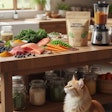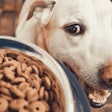Researchers at the Animal Nutrition Group of Wageningen University in the Netherlands studied the effects of petfood drying temperature and time on the food's physical and nutritional quality indicators.
The researchers conducted two factorial experiments, using four temperatures and two durations, to test the effects of drying variables on extruded canine diets produced using a 4 mm and 8 mm die. The diet was extruded using a single screw extruder at 130 C and 300 g moisture/kg. The drying temperatures used were 80, 120, 160 and 200 C, and each diet was dried in draught-forced ovens to 90 or 60 g moisture/kg diet.
Each sample was analyzed for dry matter, nitrogen, amino acids (including reactive lysine) and fatty acid content. Results showed that hardness and specific density of the diets tested were not affected by the drying temperature or time. Canine kibble durability, however, was affected by drying temperature. The highest temperature (200 C) resulted in decreased durability compared to the lowest temperature (80 C). Drying time was found to have no effects on the level of individual or total amino acids, or on the proportion of reactive lysine.
In 4 mm kibbles, drying temperature of 200 C lowered only proline, total lysine and reactive lysine concentrations. Kibble dried at 120 C had a higher ratio of reactive to total lysine than kibble dried at 200 C. Drying temperature of 200 C decreased the concentration of linolenic and linoleic acid, and increased that of oleic acid, which may indicate lipid oxidation of 4 mm kibbles during the drying process, according to the research. In 8 mm kibbles, only reactive lysine concentrations were significantly lower with a naturally associated decrease of the kibble durability.
Researchers said that drying petfoods at high temperatures of 160 C to 180 C can significantly reduce nutrients or nutrient reactivity.















